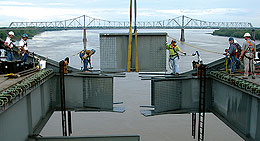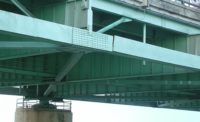All it took was a drop in temperature for the final pieces of the longest cable-stayed bridge on the Mississippi River to come together. Crews waited two days until April 21 for temperatures to fall below 70° to place the final 11-ft-long sections that join each half of the U.S. 82 Greenville Bridge project’s 1,378-ft-long main span.
 |
 |
| Replacement. Cable-stayed bridge over Mississippi River connects Greenville, Miss., with Arkansas. |
The $110-million main span project is the first phase of a $230-million replacement bridge to link Greenville, Miss., to Arkansas. The completed bridge will feature 2.5 miles of bridge deck, supported by four fans of prestressed steel strand cable tethered to two 425-ft-high concrete towers. The 101-ft-wide deck features two 12-ft lanes, a breakdown lane and shoulder in each direction.
The bridge is being built 2,800 ft downstream from the existing steel truss Greenville Bridge, which opened in 1940. HNTB, Kansas City, is design engineer. General contractor Massman-Traylor is a joint venture of Massman Construction Co., Kansas City, and Traylor Bros. Inc., Evansville, Ind.
To make the final connection, crews bolted one side of the segment in the early morning and then waited for temperatures to rise. On the opposite side, the gap closes at a rate of about 1 in. for every 10° rise in temperature, says Mike Caulfield, HNTB assistant project engineer. Crews then waited for the holes to line up to make the second connection.
Some the project’s most challenging aspects lay below the surface, where the contractor dropped two 122-ft x 80-ft floating caisson boxes into position. To prepare the site, the Army Corps of Engineers specified laying articulated concrete mattress on the bottom of the river in December 2001, to help prevent scouring. The Corps primarily uses ACM for revetment operations. The Greenville project was its first use in new bridge construction. Placing it took less than five days, a process that would have taken nearly three months using a typical timber mattress system.
Caisson guides and chevron-shaped breakwaters were built on two sites about 596 ft from each shore, where the water averages nearly 80 ft deep. The cutting edge of each caisson was floated to the breakwaters in mid-2002 and slowly sunk as concrete was poured into steel forms along the perimeter of caisson boxes.
Sinking the caissons took nearly five months, during which time water levels rose above flood stages and velocity exceeded 15 ft per second. The first caisson was dropped 145 ft into the river bottom and the other 116 ft. Each of the $20 million caissons was placed within tolerances and only required slight adjustments to the superstructure.
“Those caissons tend to go where they want to, but it worked out,” says Steve Underwood, project manager with Massman-Traylor.
Work now continues on the second and third phases, to construct two 591-ft side spans. The entire project is scheduled for completion in 2009.



Post a comment to this article
Report Abusive Comment